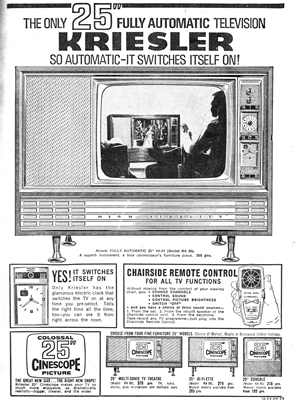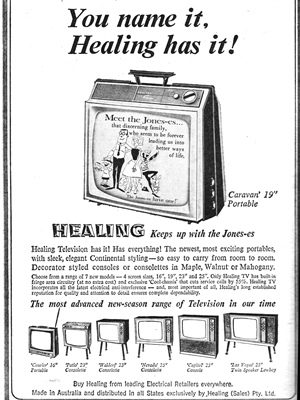 It was 50 years ago that TV Times reported that sometime around September of 1965, the Postmaster-General Department issued the two millionth TV receiver licence in Australia.
It was 50 years ago that TV Times reported that sometime around September of 1965, the Postmaster-General Department issued the two millionth TV receiver licence in Australia.
Back then, and up until the mid 1970s, any household wishing to operate a radio or television set in Australia had to purchase a licence to do so. The annual cost of a TV licence was around £6, or higher if combined with a radio licence. The revenue derived from these licences went towards funding the national broadcaster, ABC. The licence scheme was based on a similar model which is still in place today in the United Kingdom.
With more than two million sets in use across the country, Australia (with an overall population then of around 11 million, living in 3 million households) was deemed to have well adapted to the medium that had debuted nine years earlier. Viewers were also becoming more savvy as to what they wanted from a TV set — with a range of models and sizes available, the advent of basic remote controls, portable sets, earpieces for hearing impaired viewers and better picture quality — and manufacturers had been adapting to improved technology, making sets cheaper and more reliable.

In 1965, a “modern” 23 or 25-inch TV set would retail for around £200 (soon to become $400 with the conversion to decimal currency, and with inflation would equate to around $4900 today!). This is compared to 1957 when a standard 21-inch set would cost around £257. And, of course, all of these sets only displayed black-and-white television.
Fifty years ago, top of the range TV sets could come with a clock or timer, enabling the TV set to be switched on or off at pre-determined times. Other sets, such as the 25-inch “Kriesler Multi-sonic Television Theatre”, as well as a clock/timer, included a record player, radio, microphone and speaker facilities… for around £400 ($800 in 1966 dollars).

The trend was also moving towards households owning a second TV set — leading to a booming market for portable sets, usually between 11 and 16-inch screens and retailing for anywhere between around £80 and £135.
Improvements in technology meant that 1965 model sets relied less on valves, which were estimated to account for as much as 60 per cent of TV set breakdowns, and more on transistors which were more robust and less likely to have troubles. The sets also had better ventilation, making them less likely to overheat, and had eradicated the problem of “implosions” — where picture tubes would shatter inwards under atmospheric pressure!
The average household with a 1965 model set would be considered unlucky if their TV required two service calls a year — compared to an average of five service calls a year for older models.

 The design of sets in Australia had settled towards a style somewhere between the contemporary design of European sets and the larger, ‘colonial’ style that was common in the United States. Manufacturers had also experimented with larger screen sizes, such as a 27-inch model, but found the market unwilling to adopt them in sufficient numbers.
The design of sets in Australia had settled towards a style somewhere between the contemporary design of European sets and the larger, ‘colonial’ style that was common in the United States. Manufacturers had also experimented with larger screen sizes, such as a 27-inch model, but found the market unwilling to adopt them in sufficient numbers.
The next big development in the design and manufacture of TV sets was the advent of colour TV. In 1965, despite some “informal” colour test transmissions, the official introduction of colour TV was still expected to be “five to ten” years away and it was still not known which colour TV standard would be adopted by Australia.
Source: TV Times, 8 December 1965









I had not heard of the imploding screens. That must have been frightening. The good old days, as far as the physical tv goes, were not so good.
the healing television must been the first portable televisions to be released and I think they lasted until the late 1980’s the Kreisler television that switches its self on must be the first to have a sleep feature. the first television my parents bought was a HMV television with the dark red polished finish
Some of the brand ads shown in the above piece were interesting. Did you know that EMI made the Healing brand? It was a “sister” brand to HMV but I think it was only seen in Australia and NZ. The sets were manufactured at EMI’s plant at Parramatta Road, Homebush. I had occasion to visit a CD club warehouse sale some years ago(late 1990s) and the EMI plant was next door to this warehouse. What a sad and sorry sight it was too! Derelict and unused with weeds growing through cracks in the pavement. Manufacturing of TVs, stereo sets, radios, and even white-goods ceased there in 1975 thanks to Whitlam’s treachery in signing the tariff reduction bill which killed the Australian consumer electronics industry stone-dead.
whitlam was trying to control inflation which was running at 20% and would have killed the industry anyway.
the first push button set my family had was a push button models bought in 1977 until around 1992
Similar here we got a push button set in 1977. We were not the first people i knew to get colour but were the first to get push button tuner. Felt so modern…
We in Australia were not the first to have push-button station selection. I can remember back in 1969, on my way home from high school(I lived in Stockton and attended Newcastle Junior Boys High), I passed a Radio Rentals shop in Hunter Street, they had a British-made Baird(brand) colour set on display, switched on and showing a colour bar. The station selection on this set consisted of 11 pull-out knobs, labelled BBC1, BBC2(the top two) then ITV1 through to ITV9, with colour, contrast, brightness, volume and tone controls under them. The idea was to switch the set on by pulling out one of the buttons, then fine-tune by rotating the knob left(anti-clockwise) or right(clockwise). This was the first colour TV set I ever laid eyes on, needless to say it fascinated me. The station selection method was what impressed me the most.
After the HMV brand my parents bought a Canberra brand with twin speaker around 1973-74 I think it was the last valve operated set until we bought a national colour set in late 1976
On corded remote controls, my stepmother had a remote control tv in ’73 and the tv was already quite old. Of course it had a cord to the tv, so not as practical as the early infra red control. A motor turned over the tuner, at a reasonable speed once the set was warm but painfully slowly if the set had just been switched on. At times you would think the motor would never get the tuner to over to the next channel. The remote also controlled some basic settings but not the vertical or horizontal control. Lordy, fancy now having to deal with a rolling picture and tune the vertical hold with finesse.
The first colour TV I owned was a HMV-Braddon 18″ set. It had a UHF tuner fitted where you switched to Ch.11 to activate it. The set was well ahead of its time as there were no UHF signals in the Newcastle/Hunter region in 1975(I’m not sure when NBN started their Dungog translator on UHF Ch.69, and yes, it WAS Ch.69, the very top of UHF Band 5). As a result of not being used, the UHF tuner seized up and became inoperable. The next set I had was a Thorn 48T1, 20″(or 48cm) set, again with UHF tuner but on this set you had a “U” position on the VHF tuner, set between Ch.0 and Ch.11. I bought the set with lotto winnings(a second-division win of just under $500) in 1982. I had the set until it finally “cacked” itself in 2001. In all the time I had it, it only required two or three service calls….pretty good going, ay! The Braddon had several call-outs, all for the same problem – blooming and shrinking of image.
The Braddon was one of the last models made BY EMI in 1975 at Homebush. As I said earlier, when I saw that place some twenty years ago, it was a sad and sorry sight.
Hi just checking where can I download a larger version of the image ad for the kriesler 25 multi-sonic tv ?
I can email one to you, Cameron, if that’s OK.
Healing Tvs
Our first tv set was a healing. We purchased from St Clair and Leicht in Wauchope just before NRN10 Coffs Harbour started transmission in 1965. We got more exercise then as we had to walk up to tv to turn up sound, turn on off etc.
Roy Galloway